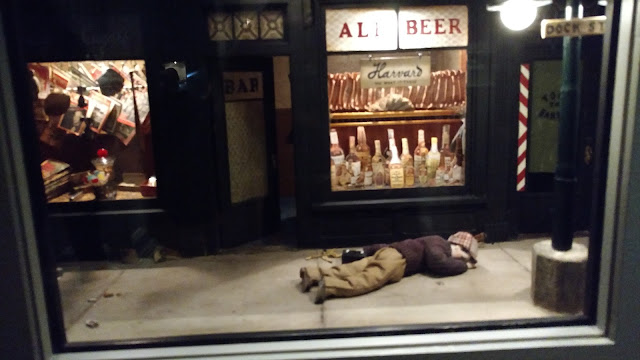For the past seven or eight years, I've done an end-of-year cumulative project with my high school forensic science class where they create a "crime scene diorama." This is loosely based off the original
The Nutshell Studies of Unexplained Death
that were created in the mid 1940s by Frances Glessner Lee.
We went today. It was somewhat chilly, but the trip from the metro station to the gallery was only about a quarter of a mile. The scenes we got to see were worth it, and my students made awesome impressions on the SAAM staff.
All of Lee's scenes were based on real crime scenes, though she embellished them a bit here and there. Overall, the scenes are true to life, and seventy-plus years later are actually still used in teaching detectives and others about crime scene investigation!
Some of the tiny details in the scenes are so minuscule, they are easily missed.
 |
| No evidence of death-by-hanging, and a missing shoe (which can be found on the stairwell) indicate this is not a suicide! |
Several of my students couldn't help but go back to certain scenes over and over again, trying to figure out what must have happened. Almost all of them came up with a theory for the "Kitchen" scene (first one above), and decided it was suicide based on the newspapers stuffed in the door frames from the inside, and the open oven.
The "Three Room Dwelling" scene elicited the most discussion and dissension. The largest of the scenes on display, the scene depicted the death of a family of three -- a baby, and then a husband and wife. It was very gruesome, with blood spatter and ballistics evidence spread throughout three rooms. In the end, my students were dissatisfied with the "real" answer, and did not like what had happened in the home, despite the evidence telling them the truth.
 |
| The kitchen of the "three room dwelling" |
 |
| Another view of the kitchen |
 |
| The nursery |
Lee did about a dozen and a half of these 1:12 scale models through the 1940s, and the detail is incredible. The lighting in the Renwick was "dramatic", with flashlights encouraged (and provided at each scene), so taking photographs was difficult.
 |
| Accidental alcohol poisoning? |
 |
| Passed out on the sidewalk and arrested for public drunkeness. Found dead in his prison cell the next day. |
 |
| Carbon monoxide poisoning? |
 |
| Accidental or murder? |
 |
| You might think it was a natural death until you knew that the pillow next to her head held a sinister secret.... |
 |
| She'd been standing on a chair to hang laundry. Then she fell and was dead. Was she pushed or was it an accident? |
Dollhouses were big in the 1940s, as a means of "teaching" a young woman how to run a household. Yet, the dollhouses that were sold were things of wealth and beauty, and Lee's dioramas showed real people, gritty and working-class, ugly and damaged. They are beautiful in their horrific-ness.
The "Murder is Her Hobby" exhibit will only be at the Renwick Gallery through January 28, 2018. The museum is open daily 10-5:30 and it's free. See it if you can!
Once we had spent close to two hours in the special exhibit, we split up to do our own thing until reconvening to head back to school. I opted to stay at the Renwick and look at the other collections before grabbing lunch.
 |
| This reminded me of engines and car parts partially buried in the mud between the C&O Canal and the Potomac River |
 |
| This is a teapot! |
 |
| A crystalline spinning wheel |
 |
| I am pretty sure the same artist did a similar (though standing) glass gown that is at the Toledo Museum of Art |
 |
| Volume. The LEDs are randomized. |
 |
| The Ghost Clock. It's not a clock wrapped in cloth; it's all carved mahogany. |
 |
| You can no longer even walk on the White House side of Pennsylvania Avenue. Our paranoid and narcissistic POTUS has it all blocked off. So much for being the "Peoples' House." |
While not as many students came on this trip as the last one, I think those who came this time actually walked away with a greater appreciation of forensic science as a whole.
Me? I thought it was a tremendously awesome exhibit, and I used some networking opportunities with the SAAM staff to hopefully set up some future field trips and/or guest speakers. And, of course, it was a day away from the daily grind!



























No comments:
Post a Comment